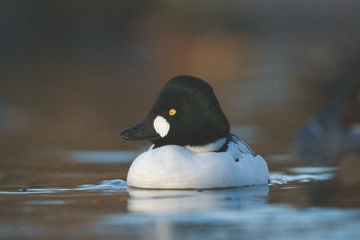Goldeneye (Bucephala clangula)

Goldeneye © Simon Booth
Goldeneyes come here to spend the winter, mostly from breeding sites in Sweden; Finnish birds tend to leapfrog these and winter in Ireland (Migration Atlas). This diving duck feeds in deep water, especially on water beetles with other insects, molluscs and crustaceans.
Although there are year-to-year fluctuations, the annual bird reports for the last forty years paint a similar picture to that found during this Atlas. Indeed, the general assessment of its status has not changed much for a century or more. Coward (1910) noted that it occurred frequently at the periods of migration, and was met with occasionally during the winter months. Bell (1962) wrote that Goldeneyes had a distinct predilection for Oakmere, Marbury, Tatton and the Langley Reservoirs where, so long as the water remained unfrozen, birds could be found throughout the winter. He added that the species is equally at home on salt water, and may be found from autumn to spring particularly in the Dee estuary in parties up to 20 birds.
Records for this Atlas show Goldeneyes almost exclusively on the larger waters, present in 61 tetrads on lakes, reservoirs and sandpits, but only one on a small water-body. Three records came from the widest rivers and one from the Manchester Ship Canal, with seven estuarine and two open sea habitat codes. They are found mostly on the deep-water meres – although those noted by Bell are less often visited – and this is one of the ducks that especially seems to favour the upland reservoirs in east Cheshire. On saltwater sites, there were no records from the Mersey, where they are scarce, but birds were found all along the Dee, where they seem particularly to like West Kirby Marine Lake.
There were no large counts and nowhere approaches the threshold figure for national importance (249): it is doubtful whether a flock of even 100 birds has ever occurred in the county. Of the 120 counts submitted during this Atlas, only 26 were in double-figures. The highest were at sites that tend not to feature in the lists for other ducks: 39 at Farmwood Pool (SJ87B), 32 on Deer Park Mere (SJ55F/K); 22 at Redes Mere (SJ87K) and 21 at the river Weaver Bend (SJ57E). The total wintering in the county probably does not exceed 400 birds.Sponsored by Graham and Dorothy Palmer

